Snow Queen Trophy Ski Race to be Held on Schedule but Without Spectators
ZAGREB, Dec 18, 2020 - The FIS international ski federation and National Civil Protection Authority have officially approved the 2021 Snow Queen Trophy, FIS World Cup Ski race on Mount Sljeme in compliance with the most stringent epidemiological measures and without any spectators, FIS announced on Friday.
In accordance with current anti-COVID measures in Croatia, the Sljeme race will be held on 3 and 6 January without spectators and guests and according to FIS rules for this season there will not be any public draw of starting numbers that was traditionally held in Zagreb's main square.
This will be the first time that the race will be held without audience and in an effort to limit contact between competitors, additional protective mechanisms have been introduced with "balloons" separating teams, the media, organisation teams without mutual mixing between balloons.
All participants have to produce a negative COVID-19 test no older than 72 hours and monitor their health on a daily basis in their FIS COVID-19 passports.
All the competitors and their teams arriving in Zagreb will be previously tested and accommodated in The Westin Zagreb which will closed to other visitors. Hotel staff will also be tested while reporters will be accommodated in another hotel.
This is the 15th edition of the Women's Slalom race with the winner being proclaimed as the Snow Queen. The Women's Slalom race is scheduled for Sunday 3 January 2021 with the 1st run starting at 12.30 pm and the 2nd run starting at 4 pm.
The 12th Men's Slalom on Sljeme will start at 12.15 on Wednesday 6 January and the second run will start at 3.30 pm.
Left-Wing Parties File Criminal Report Against Mayor Bandic for Sljeme Cable Car
ZAGREB, November 23, 2020 - The We Can! and Zagreb is Ours! political platforms on Monday filed a criminal report against Zagreb Mayor Milan Bandic for abuse of office and power and for illegal favouritism related to the construction of the Sljeme cable car.
"According to the conspirator who sent a video to all media outlets with clear evidence, DORH (Office of the Chief State Prosecutor) and the USKOK anti-corruption office should already act ex officio. However, I am filing a criminal report against Bandic for abuse of office and power, graft and conspiracy to commit crimes" Councillor and MP Tomislav Tomasevic said.
That is not only Bandic's but also Andrej Plenkovic's cable car
He filed a criminal complaint also so that institutions would report to him on what they had done, he added.
"For this 13 unlucky years, the City of Zagreb has been waiting for the repair of the old Sljeme cable car or for a new one. The HDZ (Croatian Democratic Union) even set the construction of a new cable car as a condition for forming a coalition with Milan Bandic. So this most expensive cable car in Europe is also HDZ's cable car, not only Bandic's, but also Andrej Plenkovic's cable car," he said.
Coordinator for cable car construction from Bandic's party
In addition to that, in 2016 Bandic appointed Vladimir Gruborovic, a member of the the Main Committee of Bandic's party, as the coordinator of the team for the construction of the cable car, which includes representatives of the City Administration and all city companies.
That is more than enough evidence, Tomasevic said.
PHOTOS Autumn Day on Sljeme, Zagreb's Favourite Excursion Site
November 8, 2020 – Although Zagreb has been shrouded in fog on Sunday morning, it has been a sunny autumn day on Sljeme and its forest.
Standing 1000 meters above Zagreb, the highest peak of Mount Medvednica, Sljeme, is the perfect and most favourite weekend excursion site for many Zagreb residents, as well as people from the surrounding area.
Although the fog did not look promising on Sunday morning, many Zagreb recreationists and excursionists still decided to head to the highest peak of Zagreb. And they did not regret it, as the sun appeared just after the first hills. Climbing to an increasing elevation, the fog slowly but surely disappeared, and the late autumn sun shone through the already half-bare branches of the Medvednica forest.
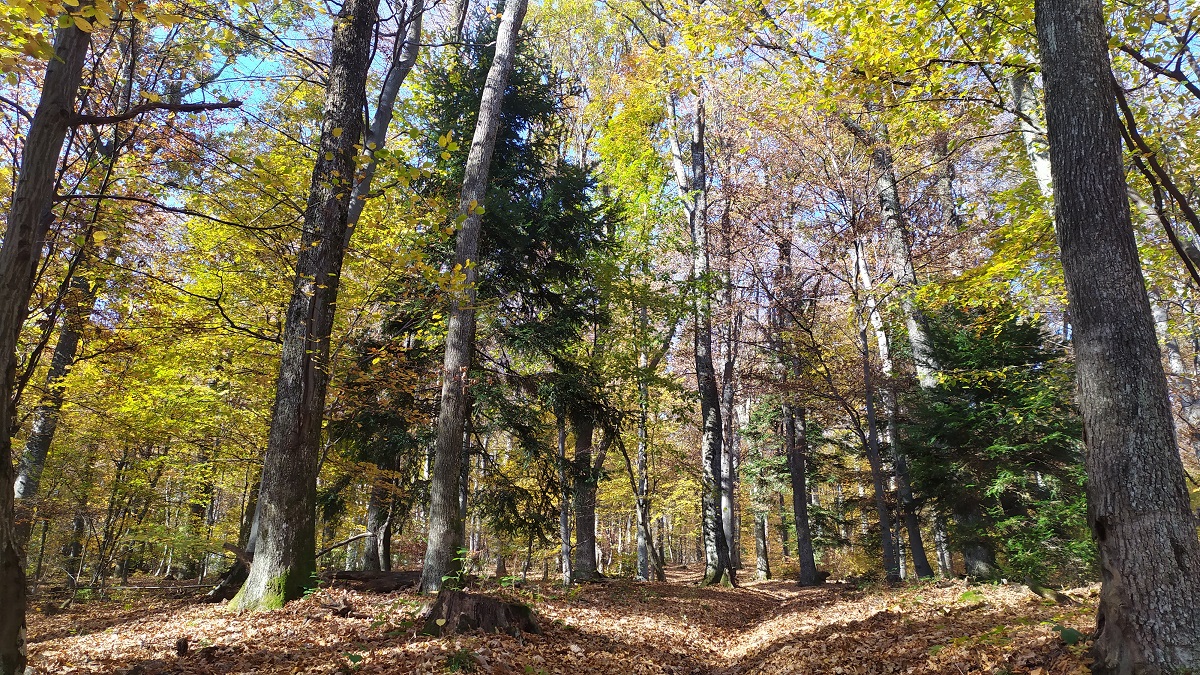
Sljeme (1033m), the highest peak of Medvednica or Zagrebačka Gora, as it is also called, can be reached on foot and by bike on hiking trails, or by road. From 1963 to 2007, the Sljeme cable car was in operation, and a new one is currently under construction, and should have its first test run of only 16 minutes very soon.
The area of Medvednica is also a nature park of the same name, and along the walk or ride through the beautiful forest, it is possible to get to know more than 1000 plant species. You can find your peace on as many as 70 hiking trails, and listen to the murmur of water from 70 streams. Exactly because of that, but also because of the immediate vicinity of the Croatian metropolis, the interest in visiting Medvednica and Sljeme is great throughout the whole year, and mostly on weekends.
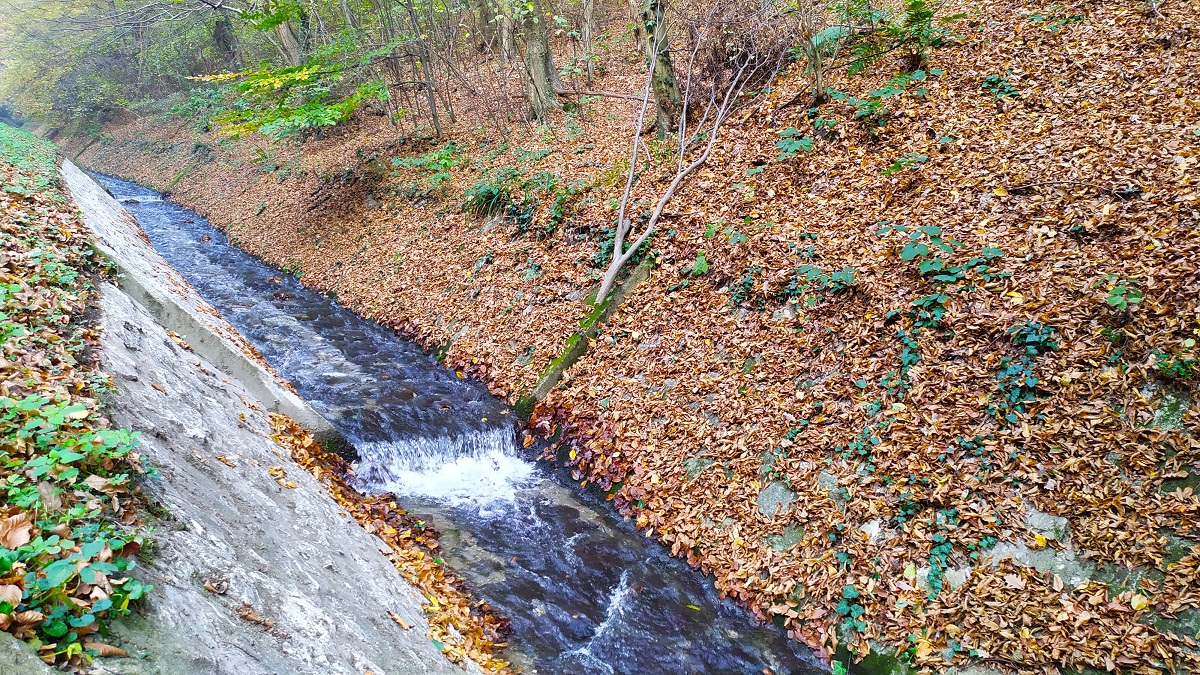

Apart from the beautiful untouched nature, there are other tourist attractions in the Medvednica Nature Park, such as the old medieval fortress Medvedgrad. The Veternica Cave, the sixth-largest in Croatia, and the Zrinski Mine, cultural heritage of the Republic of Croatia, are also an indispensable part of a visit to the park.
Since 2005, Sljeme has been the host of the Snow Queen Trophy ("Snježna kraljica"), women's slalom race of the World Ski Cup. The original name of the race was the Golden Bear ("Zlatni medvjed"), but it was changed in honor of Janica Kostelić, legendary Croatian skier, without whose sporting success the race would not have been given to Croatia and Zagreb to organize. Apart from that, Sljeme is also well-known for its television tower, visible from every part of Zagreb, and the Restaurant Vidikovac.
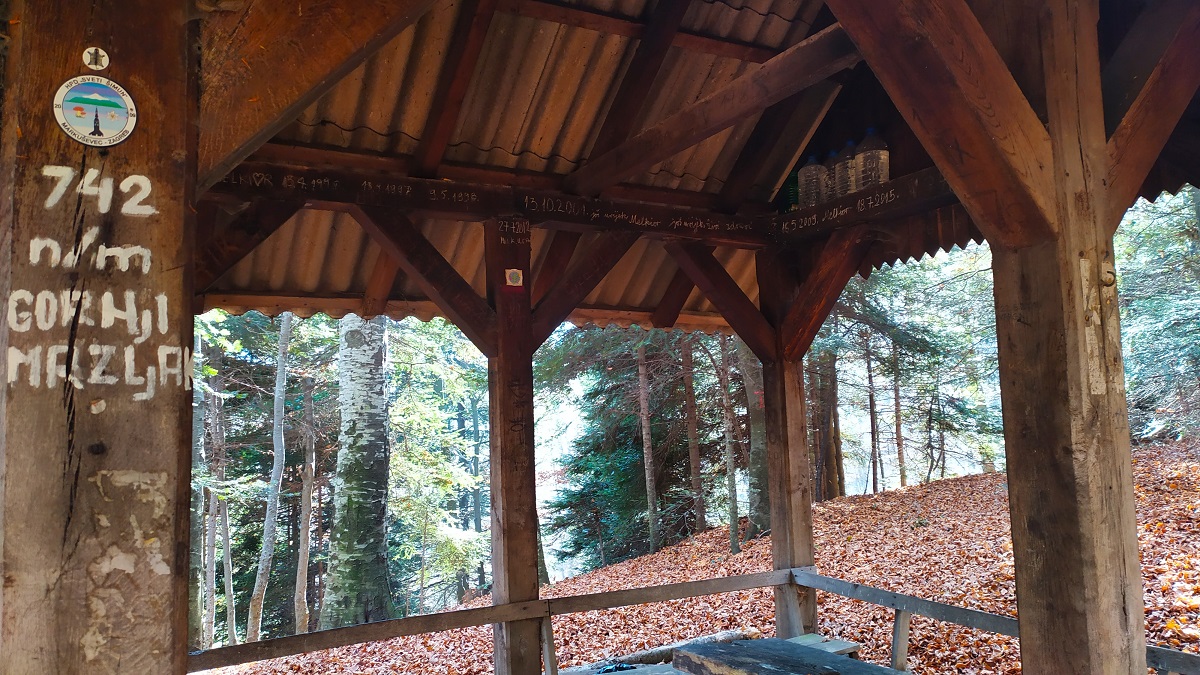
After a few hours of climbing, depending on the chosen route, hikers most look forward to eating homemade beans or baked “štrukli” and sweeten with strudels in the famous Mountain Lodge Puntijarka (947m).
The descent, due to fallen brown leaves and swept stones, is as challenging as the ascent to Sljeme, but the pleasure of observing the stems and treetops is even greater.
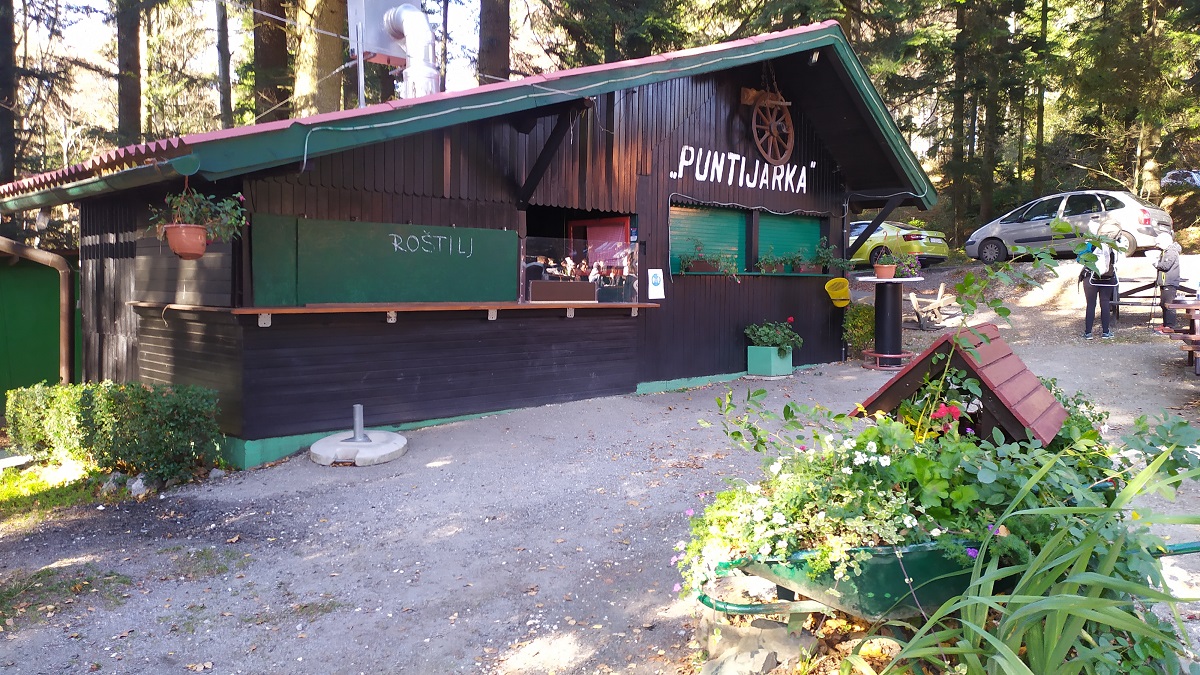
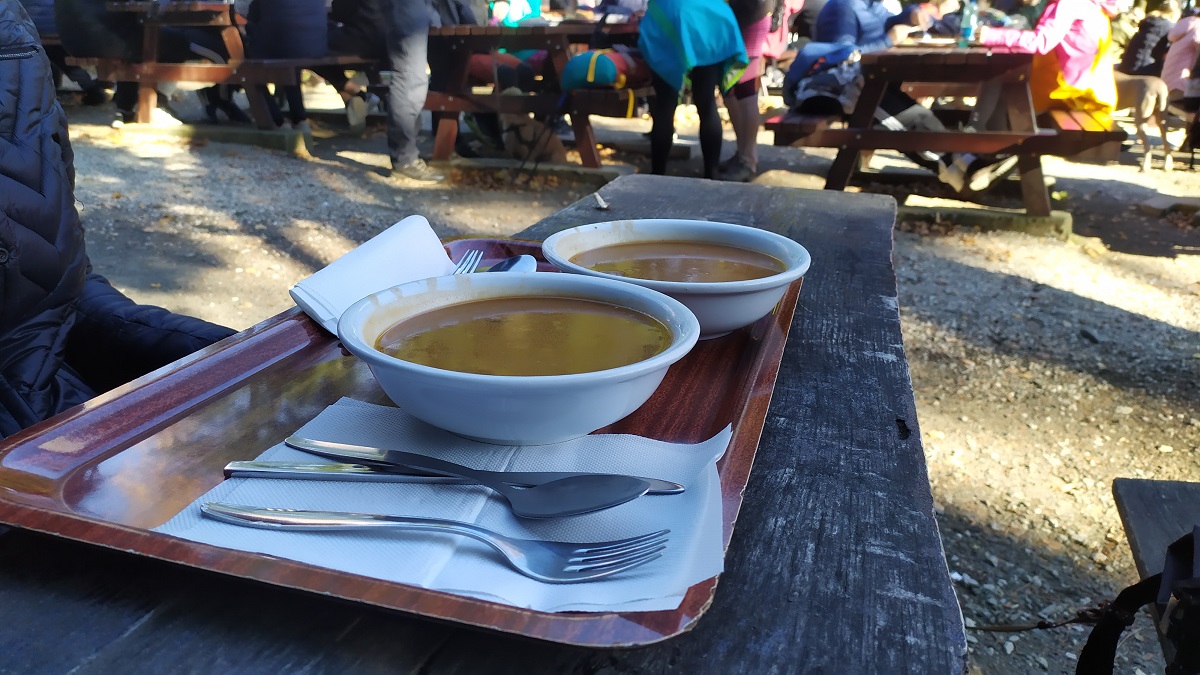
All photos © Donatella Pauković
For the latest travel info, bookmark our main travel info article, which is updated daily.
Read the Croatian Travel Update in your language - now available in 24 languages
Meet HGSS The Croatian Mountain Rescue Service
August 19, 2020 – All weather, all terrain, all year round – meet HGSS The Croatian Mountain Rescue Service, amazing volunteers who will never let you down
They're never far from the news. For the last two weeks, members of HGSS The Croatian Mountain Rescue Service have yet again been on the TV news every night. They're leading the search for a summertime visitor, a Polish hiker missing on Biokovo mountain.
But, watch again this winter and, for sure, they'll be in the headlines once more. Whether, they're scaling mountain ranges in the unbearable heat of high summer, searching underwater caves, flooded rivers or the sea, breaking through wild forest or trudging through metres of snow, they undertake their search and rescue missions over every terrain, in every weather condition, in every month of the year, all across Croatia. And, they all volunteers.
Marc Rowlands meets the head of service for HGSS The Croatian Mountain Rescue Service and three of its volunteers to find out who they are and what makes them do what they do.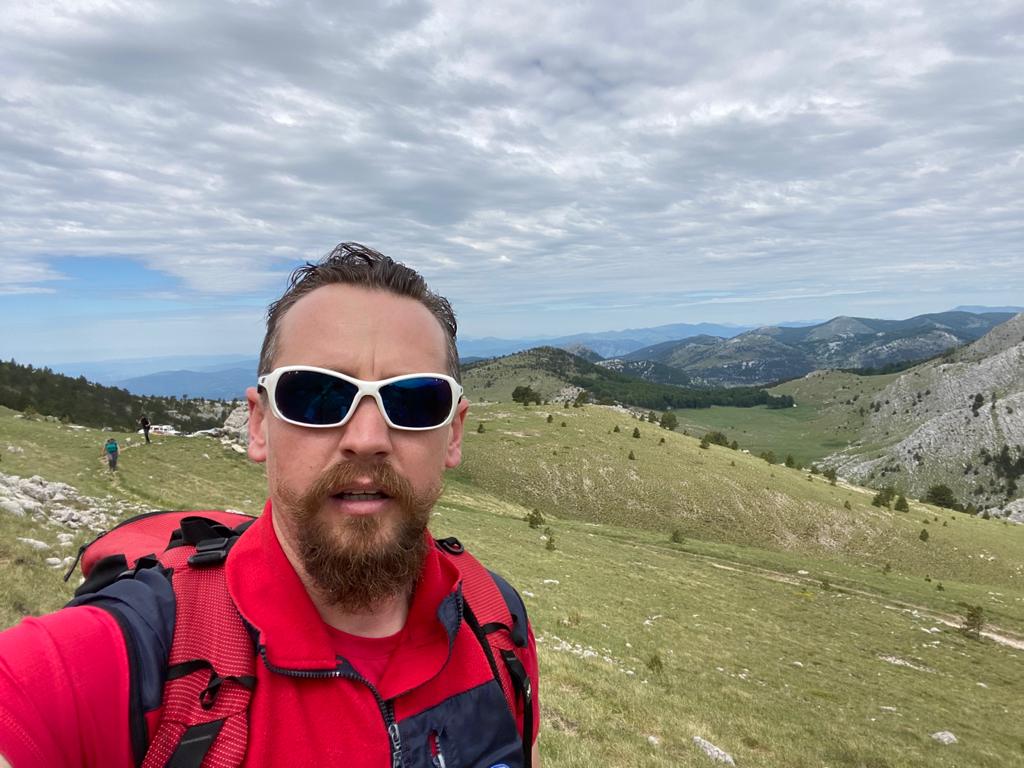
Josip Granić, head of service for HGSS The Croatian Mountain Rescue Service
My name is Josip Granić. I'm the Head Of Service for HGSS The Croatian Mountain Rescue Service. We've had an extremely busy couple of weeks. Being head of service for an organisation like this under such circumstances means you're always on the phone; co-ordinating, talking to outside organisations, members of the press. Communication. It's a 24/7 job, 365 days a year. If people need help, you can't take a holiday. Not at this level of the organisation.
We have around 1000 members. There are 11 paid positions in the main organisation and 25 people we pay to run the administration in each of the teams or stations we have. All of the members who perform the search and rescue are volunteers. We have pilots, surgeons, nurses, students, professors, every part of society.
I'm originally from Kaštela, but my home station is in Karlovac. I've been there for 15 years. I've been Head Of Service for two. Since I assumed the position, I've spent most of my time in the car. I travel all over Croatia.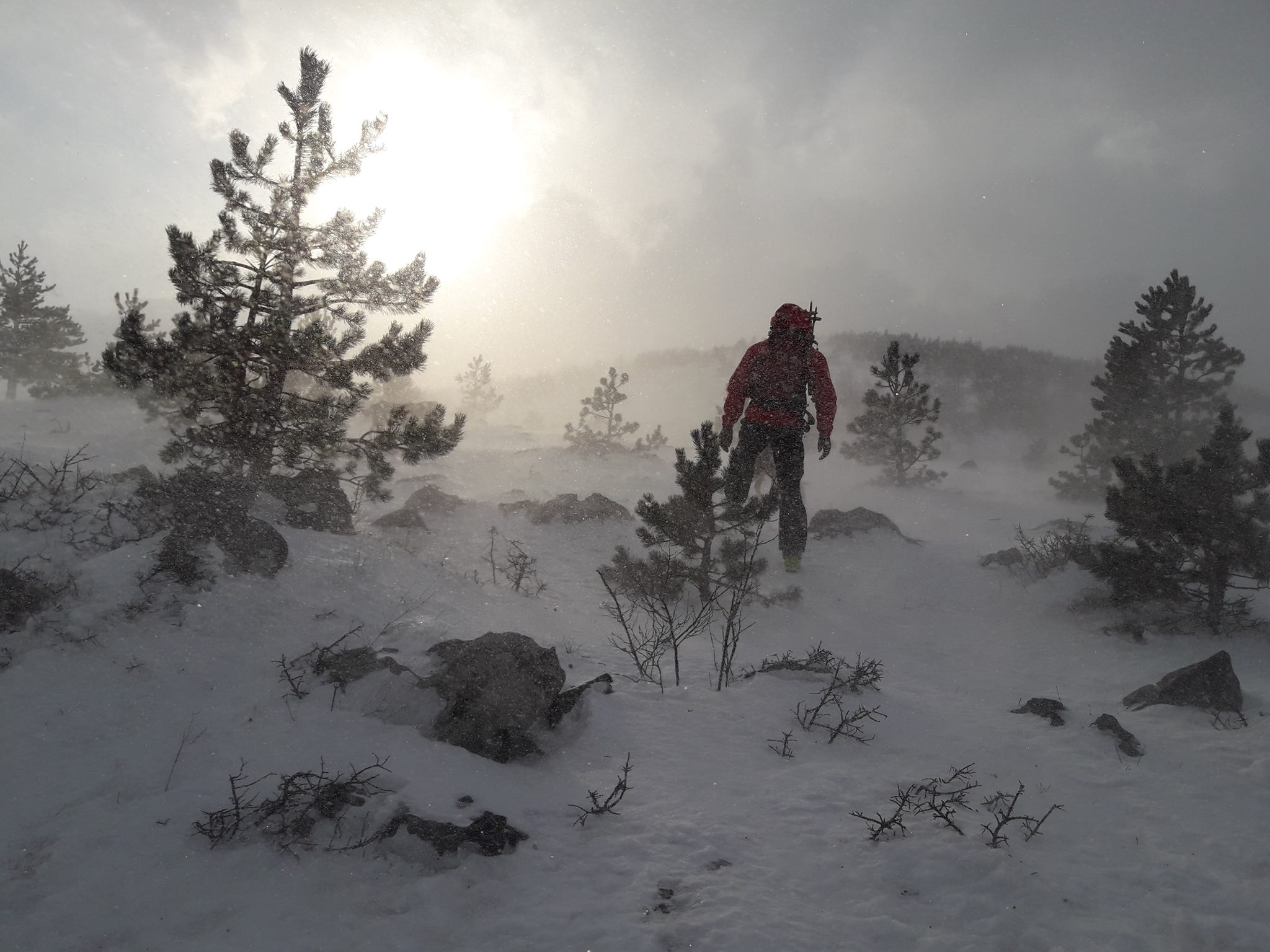
HGSS The Croatian Mountain Rescue Service missions can be hampered by extreme weather conditions © HGSS The Croatian Mountain Rescue Service
To get a certified position as a mountain rescuer in Croatia you all do the same training. It doesn't matter if you come from Slavonia, Dalmatia or Istria, you must have the knowledge and ability to deal with circumstances in any terrain; caves, pits, mountains, on snow, underwater.
Depending on where your station is, the type of call-outs you get could be very different. In Slavonia, 90% are for missing persons - searching forests, rivers, and in floods. We've had a big search on Biokovo mountain for the past 16 days. The stations from Split, Makarska, and Dubrovnik were at first involved, then teams from all over Croatia. It's not the same as Slavonia. The terrain is very different, so you have to be good at a particular set of skills. But, the largest percentage of call-outs is still missing persons. It's 70% of our work nationwide. The other 30% are rescues.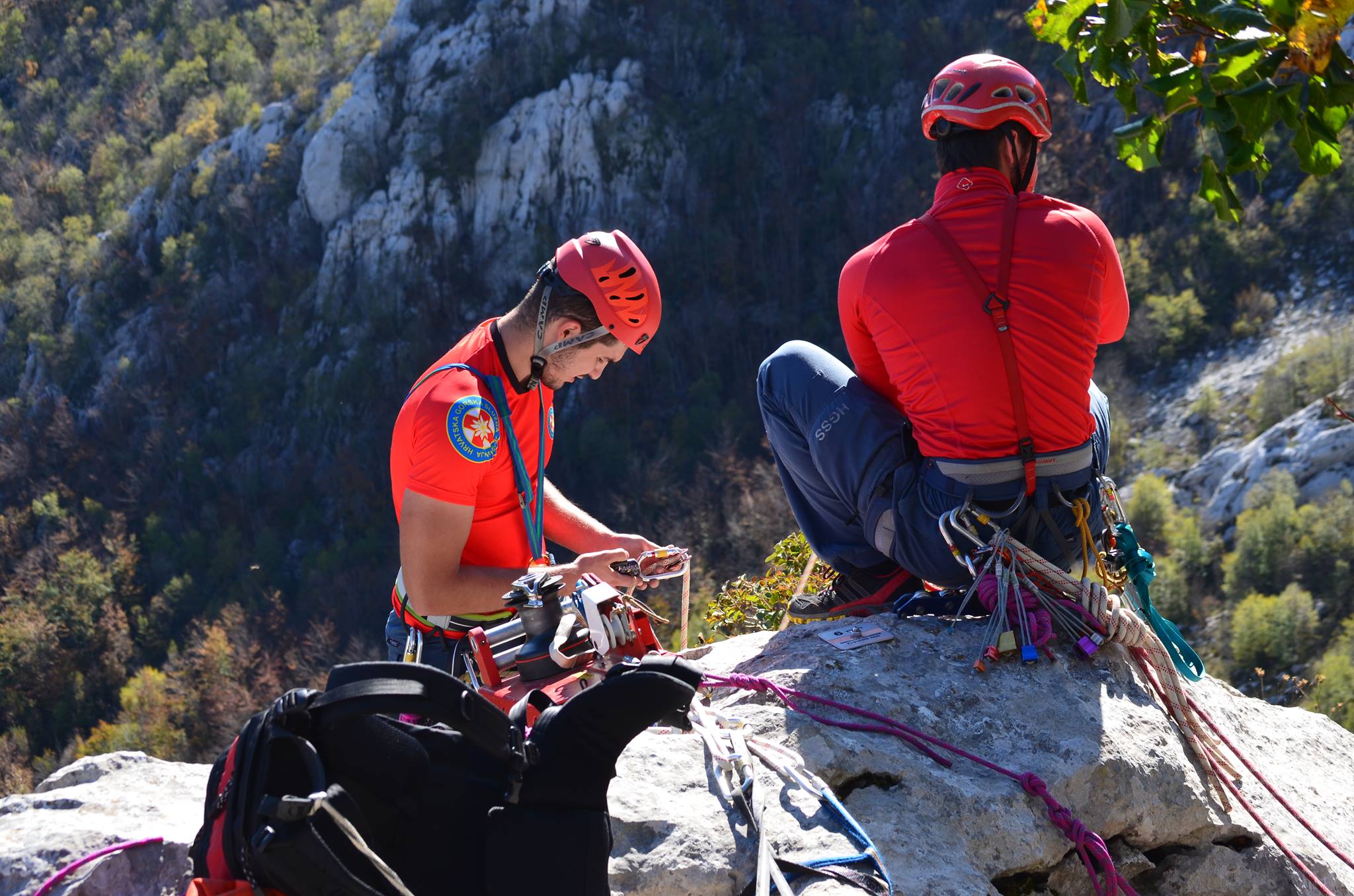
HGSS volunteers are educated to use a wide range of technical equipment. They are trained to operate in all the different kinds of terrain found across Croatia © HGSS The Croatian Mountain Rescue Service
There are usually 800 – 1000 missions a year across the country. We get roughly the same amount of calls in colder months as in warmer months. Only, winter months can be busier. The terrain is more difficult. There are some villages in Croatia – usually where the front line of the fighting was, around Karlovac, Kordun, Lika – and when it snows, it can be almost impossible to reach those places. But, some older people still live there. It can take days to reach them on snowmobiles, then skis, to deliver food or medecine. The other busiest places in winter are the ski resorts - Platak, behind Rijeka, and in Zagreb, on Sljeme. There are teams stationed in those places throughout the snow season.
What's the greatest danger of the job? Almost everything. Nothing in this job is easy. The greatest dangers we face are the same facing those that we rescue - underestimating the environment, nature, the conditions. That's where our training comes in.
In mountain rescue, we separate dangers into subjective, objective and technical. Subjective is the stuff you're guilty of - lack of preparedness, knowledge or equipment. Objective dangers are the ones you can't control, like sudden changes in weather, or avalanche. If you're sensible and informed, there should be no objective danger.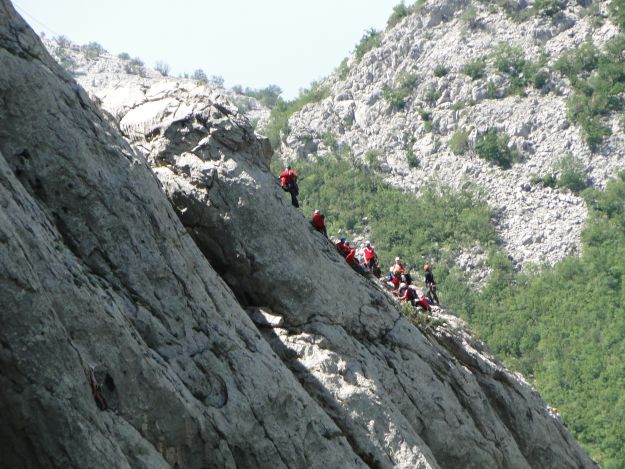
HGSS on a mission, clinging to a steep incline in Paklenica © HGSS The Croatian Mountain Rescue Service "People need to be aware at all times on the mountains. By the time most people think they may be in trouble, they've usually been in trouble for five or ten minutes already" Josip Granić.
80 – 85% of the people we rescue are Croatian. Only 15 – 20% are guests. People from Czech Republic, Slovakia, Poland, (Austria and Slovenia too) tend to enjoy nature more. They like hiking. That's the reason there are typically more rescues for those nationalities than there are for British, Belgian, French, Italian, America, Canadian or Australian guests. I don't remember the specific year, but sometime between 15 and 20 years ago we had a season where 5 or 6 Czech nationals were being searched for or, sadly, turned up dead. The media covered it and ever since there's been this myth that all the people who get into difficulty are Czech.
The question about expensive helicopter rides - why don't you charge the people you rescue - has been here forever. It's like this - if you're a tourist and you have a car accident in Croatia, the fire service, police and an ambulance will come. You won't get charged. We are a tourist country. According to international agreements, we are obliged to make everything safe for residents and guests alike. We are here, just like the fire service and police, to do our part. The Croatian air force is responsible for the helicopter rides and I have to give credit to them - they are crazy good pilots. Amazing. Even if we did charge everyone we saved - and most of the 85% of Croatians we save would struggle to pay - it still wouldn't be anywhere near the money required to run this service.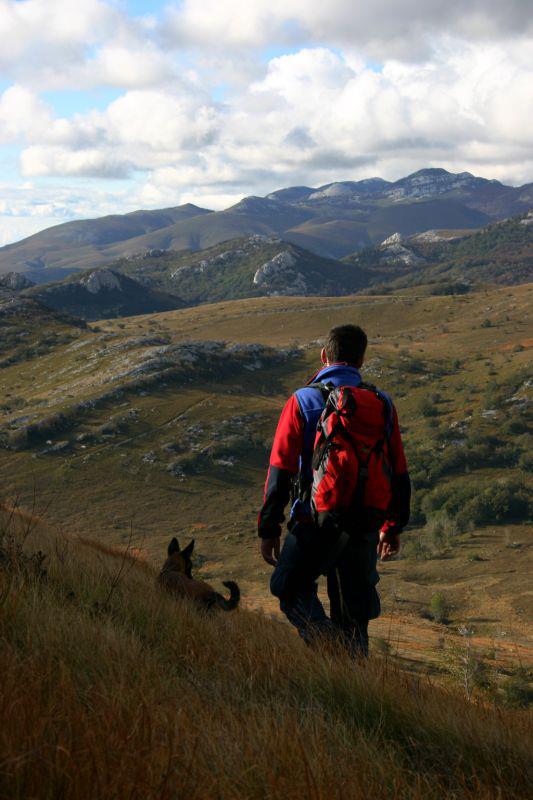
The Croatian Mountain Rescue Service used specially trained dogs on their searches © HGSS The Croatian Mountain Rescue Service
In 2007, I got a new search dog. It came from the Ogwen Valley Mountain Rescue service in North Wales. We cooperate a lot. We were sent out on a job to look for a three-year-old male child who had gone missing near Požega at the beginning of January, wintertime. His grandma was watching him and they were in a house on the edge of the woods. Early in the morning, he was playing with a dog. It suddenly ran into the forest and the boy chased after him. The grandmother didn't see it happen. I found him using my new dog, just after 8 o'clock the next morning. He'd been alone in the freezing forest for almost 20 hours.
Time is really moving fast on a job like that, because it's a kid and because it's so cold. Survival rates in such conditions are not good after 24 hours. When I found him, saw that he was alive, those big eyes looking up at me, it's a crazy feeling. You can't describe it. You can't compare it. A lot of positive emotions.
Every mission is special. We meet them all with the same level of determination and professionalism. But, it's the ones where you know you've really saved someone that stand out in the memory. Not the broken leg, where you transported someone – sure, that's an excellent job. But, when you know you've saved someone's life, that they definitely wouldn't be here now if it weren't for you, that's what makes it all worthwhile.
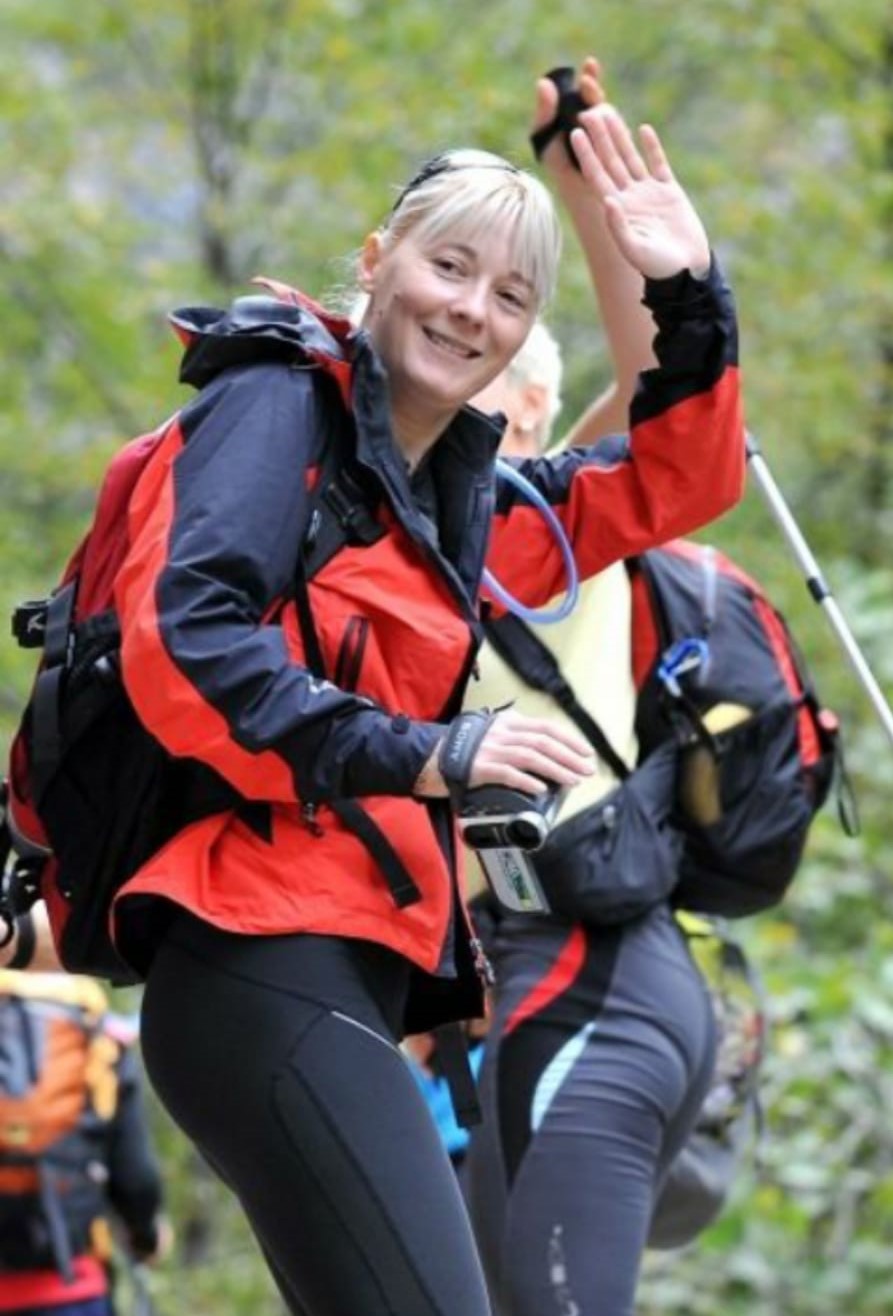
Jana Mijailović, volunteer for HGSS The Croatian Mountain Rescue Service
My name is Jana Mijailović, I'm 48 years old and I'm from Zadar. I finished school to be a teacher, but I never did it. My husband and I run a company that does plastic and aluminium windows for houses.
I started to go into the mountains when I was at high school. I never had the ambition to be part of mountain rescue services – people just noticed me on the mountains. They said I'd be good at it and asked me to join. I met my husband on the mountains. We are both volunteers for HGSS The Croatian Mountain Rescue Service. I've been doing it for 16 years.
I was a member of the first and second all-female Croatian expeditions to the Himalayas. We first climbed Cho Oyu in 2007, then Mount Everest in 2009. Croatia is the only country in the world that has only one successful male climber of Mount Everest, but four successful female climbers. I sometimes work as a guide too. I guess you could say I'm all about the mountains.
Being a climber, an Alpinist, I know that if I get into trouble, it's only my HGSS colleagues who can help. I feel this instinctively. I cannot be in the house, safe and warm, knowing that maybe someone needs help that only I can provide.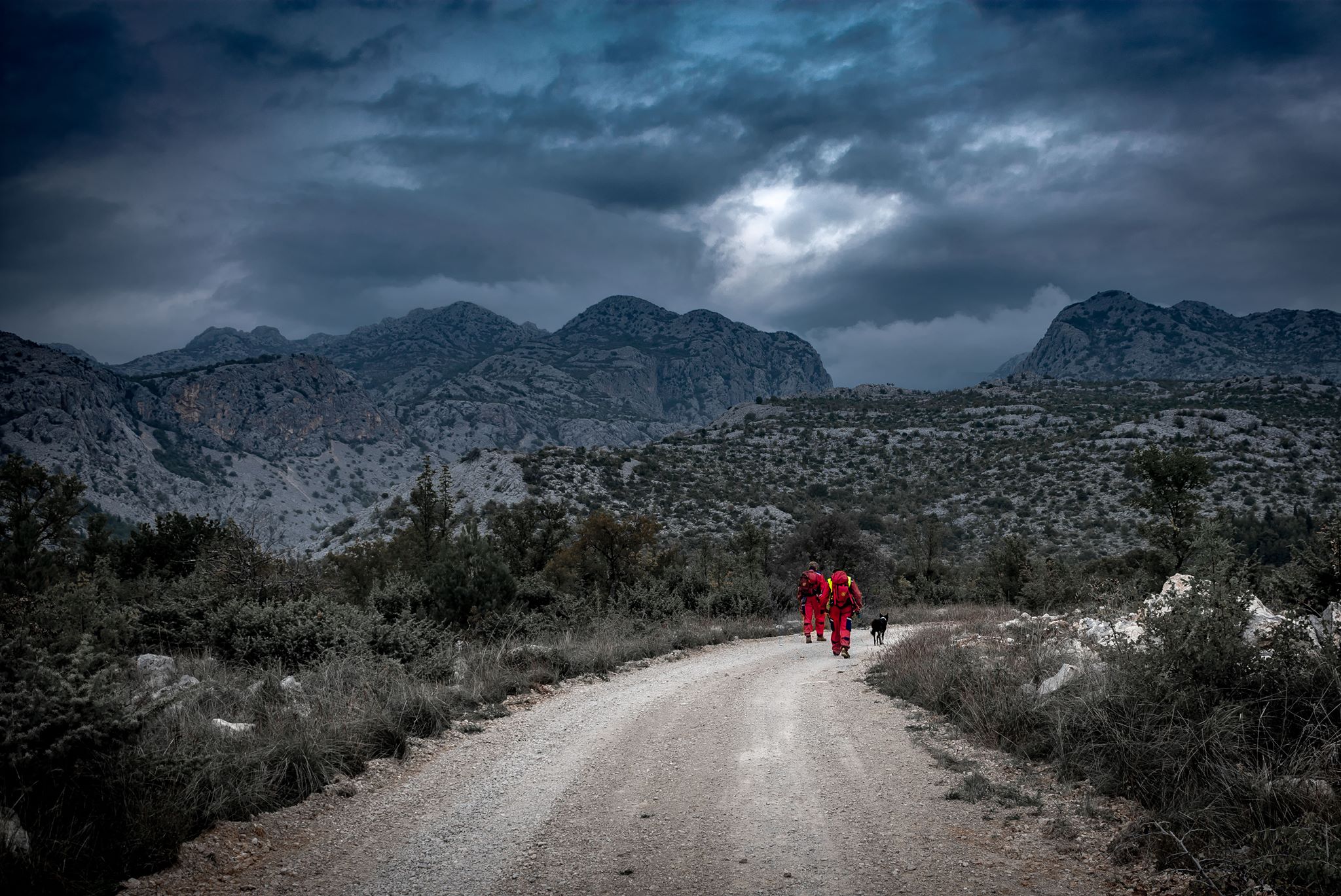
HGSS The Croatian Mountain Rescue Service members entering Paklenica under foreboding skies © HGSS The Croatian Mountain Rescue Service
I've really been on so many expeditions with HGSS. My station are on duty in the season at National Park Paklenica and I'm now the coordinator. Climbers from all around the world come and so there are many interventions. None of them are easy because the terrain is incredibly difficult. You really have to be in shape and know the techniques inside out.
I'm very proud of my statistics. Everyone I've rescued, who was alive when I reached them, is still living today. Unfortunately, not everyone we reach is alive when we arrive.
I remember one time, my husband and I were having dinner. We were arguing about the techniques and knots for moving a stretcher down a vertical climb. The training is so intense, you really have to know it well, and I guess that's just the kind of people that we are, that we would be arguing about it in our free time. Ha! He told me, "Why do you care? You'll never have to do that," because usually, it's really strong guys who do that specific job. If you're on a 400-metre-high section of rock, it really takes a lot of muscle.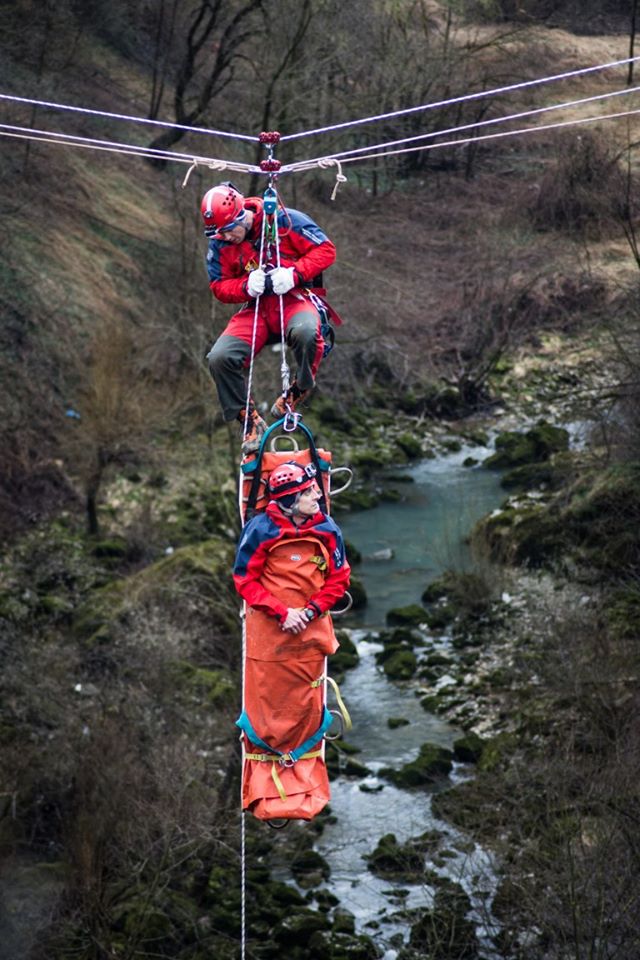
Ascending from a valley floor or descending from a mountain peak with a stretcher is a technically difficult operation, often hindered by darkness and adverse weather conditions. It requires a lot of training and a lot of muscle © HGSS The Croatian Mountain Rescue Service
In the evening, just two days later, we were called out to rescue an Italian guy who broke his leg on Anića Kuk. It's a really mighty part of the stone. And the leader of the expedition asked me to go on the stretcher. They pull you down on the ropes and you have to push very hard to keep the stretcher, the person you're carrying and yourself away from the rock, while balancing the weight of all three. It was dark, raining and with lots of Bura, the incredibly strong wind that sometimes hits us. That's probably my most memorable rescue.
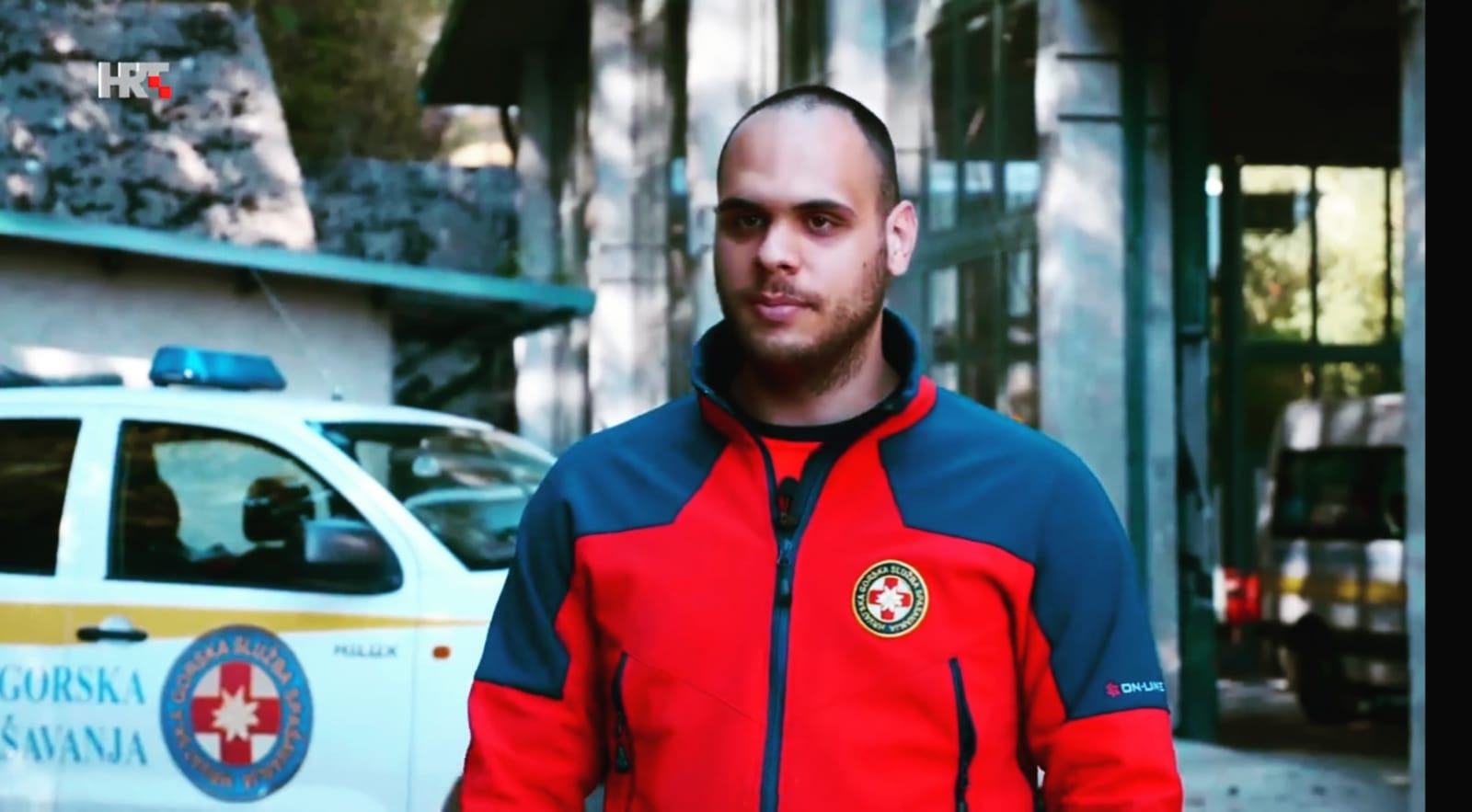
Petar Prpić, firefighter and volunteer for HGSS The Croatian Mountain Rescue Service
My name is Petar Prpić, I'm 25 years old and I'm from Hrvatska Kostajnica, just on the Croatian-Bosnian border. My station is in Novska. In my full-time job I'm a professional firefighter. I guess I have two dangerous jobs. Well, one job and one hobby.
I've always been interested in the outdoors – mountaineering, hiking, canoeing. But, that's not why I joined HGSS The Croatian Mountain Rescue Service. I just wanted to help people. I don't know, I guess it's just something in me.
We have a lot of rivers in our area. During the times of flood, we get a lot of call-outs. Our part of the country has a high percentage of elderly people in the population. A lot of them live in small villages, on the edge of the forest. We get a lot of call-outs for searches. Especially in the autumn when people go out looking for chestnuts or mushrooms. But, like all the stations in Croatia, we are here year-round if there are any actions in other parts of the country that need us.
In some areas, HGSS The Croatian Mountain Rescue Service are frequently called out in response to flooding. This picture shows HGSS members on operation during the 2014 floods. In that year, flooding across the whole region was so bad that HGSS members operated not only in Croatia, but also donated their services to neighbouring Bosnia and Serbia © HGSS The Croatian Mountain Rescue Service
I was just on the search in Biokovo. The head of service called me and asked me to go. I first had to get some free days from my job. I called my boss, Zvonimir Ljubičić, chief of the fire department. He's great, very understanding, and he gave me permission. Two years ago I was called to Rab. Very hard operation, very difficult terrain.
Late last summer, we were called out to look for an older man near Glina. It was around 11 o'clock in the evening. He'd gone to look for mushrooms in the afternoon and never came back. Police were there and they sent for us.
The man had a cell phone on him, but there was no signal. There was no location given off the phone. We were a team of four, split into two teams. We went up into the woods above Glina and concentrated our search on areas where we could see there was no telephone signal on our phones. We were yelling in the dark. After an hour of search, someone answered. He'd been missing since 2pm. We found him at 2am. He was just lying there, uninjured but unwell, unable to move.
The reason it sticks in my mind is that the next day, in the morning, his daughter called me. She was so thankful, so emotional. For sure we saved his life. None of the other emergency services who were present could find him. It was down to us. We finished the operation at about 6am and then all four of us had to go immediately to our regular jobs.
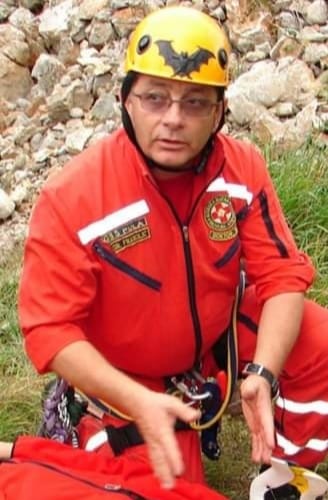
Mario Franolić, physician, ex-commando and volunteer for HGSS The Croatian Mountain Rescue Service
My name is Mario Franolić and I'm 60 years old. I'm the chief of the mountain rescue service in Istria. I travel throughout Croatia because I'm also an instructor for the medical commission of HGSS. I was born on island Krk. I'm based in Pula although I work in Rijeka. I travel a lot between the two. I've been with HGSS The Croatian Mountain Rescue Service for 18 years.
In my day job, I'm a physician. I am a senior mentor at the Institute for Underwater and Hyperbaric Medecine in the Clinical Hospital Rijeka. I'm an expert in my field of emergency medecine. I've been doing it for almost 30 years.
When I was young, I trained to be a physician in Belgrade. It was then the best medical faculty in Yugoslavia. At the same time, I also started spelunking (cave exploration). I've been doing it since 1978. Later, I was a physician in the military underwater commando unit. I lived in Austria for five years, but when I came to Pula, they were just starting the HGSS The Croatian Mountain Rescue Service station here. They asked me for help because they didn't have any medical professional on the team. I accepted. It would be a waste not to use all these skills I have.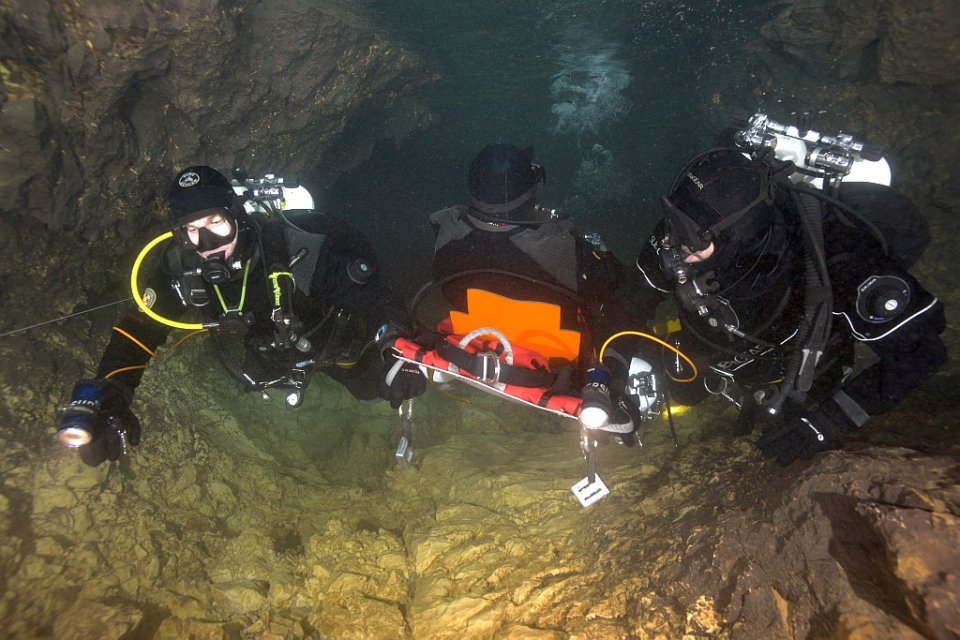
Specialist teams from HGSS are trained in underwater rescue from caves. Such caves exist all over Croatia in the karst rock, and also on some islands © HGSS The Croatian Mountain Rescue Service
Sometimes, our status as volunteers can give us problems. Although we have official duties, we are more like an NGO than something like the police. There can be legal implications. I remember one situation, very acute because a paraglider fell from the sky. None of his colleagues saw him fall. Paragliders go into the air together, but then they each branch off to do their own thing.
We had no idea about the location. We started from the last point of sighting, knowing that it could be very far from the place where he actually fell. But, we had to start somewhere. We had one mobile phone signal direction. But, you need three in order to locate someone. We only had a line on the map.
In the past, HGSS The Croatian Mountain Rescue Service sometimes had difficulties because the telephone companies wouldn't give us the information we needed in order to triangulate the position of a missing person. They would only give it to the police. But, it's a race against time. We searched for this man all day and all night. In the morning, some Croatian paragliders made private contact with a guy from the phone company. They begged him to release the information we needed. Although he could lose his job, giving such information to private citizens, he did it.
We found the man about 150 metres from where we were. Sadly, he was already dead. It was very small comfort to see that he had died instantly, on impact. It's unbearable when you reach someone you could have saved if only you had got there quicker, especially in an instance such as this, where we were hindered by a lack of information that was available. I think it moves more quickly now, but still we have to go through the police.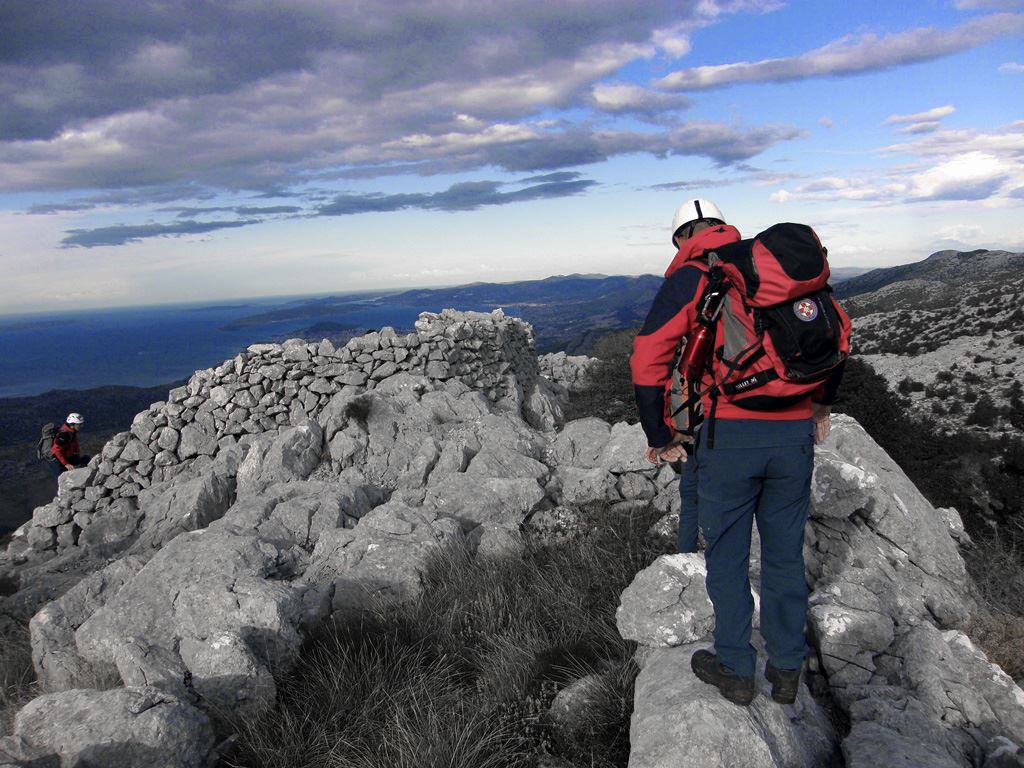
© HGSS The Croatian Mountain Rescue Service
One of the most emotional operations I went on was around five years ago, the rescue of a young girl - maybe two and a half to three years old – who got lost in the woods in a small place in central Istria. She chased into the forest after some dogs around 10 or 11 in the morning. The family saw immediately that she had disappeared and started to search. About two hours later, we were called out. It was impossible for the family to find her.
About 300 people came – my station, the Rijeka station, hunters, firemen, police and volunteers. In such an operation, the police are the lead service. But, 99% of the time they leave the organisation of the search to HGSS The Croatian Mountain Rescue Service. We are the only organisation who is very well educated in organising searches. When other people do searches, they use intuition. But, people all have different intuition. It can be chaotic. We are highly trained for this. There are procedures, recognised internationally, that we follow. We found her early in the morning, at around 7 o'clock. The dogs were lying on each side of her, giving her warmth.
All photos courtesy volunteers and HGSS The Croatian Mountain Rescue Service
Gondolas Able to Accommodate 10 People Arrive at Sljeme Cable Car
Sljeme is a favourite destination for many of Zagreb's residents. From skiing in the winter months to hiking and enjoying the views in the dense forests just above the Croatian capital in the summer months, what you can do on Zagreb's famous hill varies with the changing of the seasons. The Sljeme cable car, a project that was in the works for a very long time indeed, is yet another addition.
As Poslovni Dnevnik writes on the 17th of July, 2020, there will be about eighty gondolas placed at the Sljeme cable car, they will move six metres per second and will be able to carry 1,500 passengers in just one hour. The very first cabins of the Sljeme cable car, mounted on steel cables with which they will slide along, were installed over recent days.
One was photographed at the very top of Medvednica, which is the first time that a gondola has (almost) reached the height of the TV tower itself, given that the new Sljeme cable car route is one hundred metres longer than the old one was. One cabin is ready at the lower station, and the first test rides are along the route, as has been found out unofficially from the construction site, will begin at the end of August.
The opening of the Sljeme cable car itself is planned for All Saints' Day, according to a report from Vecernji list.
The new cabins, on the other hand, are 2.1 metres tall and two metres wide, they will accommodate a maximum of ten passengers at a time who will be able to sit on two folding benches. They will also be adapted for people in wheelchairs, and they will be able to accommodate stretchers for the injured.
Skiers and the like will be able store their equipment in special carriers, but there will be no such facilities for transporting bicycles, which will therefore be able to be transported in the gondola itself. The cabins were delivered by an Austrian company specialising in the construction of the Doppelmayr cable car, where all the equipment comes from. They arrived late, as the borders were closed due to the coronavirus pandemic.
For more on the Sljeme cable car and other things to do in the Croatian capital, follow Total Zagreb or check out Zagreb in a Page.
Irresponsibility in Coronavirus Era Costs: Will Zagreb Parks Close?
Croatia is not in quarantine, and that's extremely important to point out. People can leave their houses amid the coronavirus pandemic, but not their cities/counties/towns of registered permanent residence. People are free to leave their houses to go to pharmacies and the food stores which remain open as they're of course classed as essential.
What people cannot do, is gather together, wander and sit around aimlessly on benches, on streets or in parks. Social distancing, however it may sound to some, appears to be an effective way of controlling the spread of coronavirus.
Across Facebook, there have been countless posts from people asking if lockdown was over now, because of the amount of people running, jogging, walking and appearing to have very normal family days out in parks. This has unfortunately been especially true in Zagreb, where, ironically, the most coronavirus positive patients are located.
As Poslovni Dnevnik writes on the 11th of April, 2020, in the face of people continuing to break the rules, the National Civil Protection Headquarters has warned that there has been no relaxation to the country's stringent anti-epidemic measures, because any failure to comply with the instructions will only prolong this less than ideal situation and put people's health and in some cases, lives, at even more risk.
As Jutarnji list has unofficially reported, in the next few days, there will be increased control of all areas where the gathering of more people has been recorded.
Failure to adhere to the measures which are firmly in place, for which violations are punishable, more specifically, failure to reduce the crowds on popular promenades, picnic areas and parks would result in the complete closure of such areas, which, in Zagreb in particular, would mean the closure of Bundek, Jarun and even Sljeme.
Make sure to follow our dedicated section on coronavirus in Croatia for rolling updates and important information.
How Much Could Ticket for New Sljeme Cable Car in Zagreb Cost?
As Poslovni Dnevnik writes on the 27th of January, 2020, on May the 31st, 2020, after almost thirteen years of waiting, Zagreb's residents and visiting tourists will finally be able to sit in a cable car in Gračani and reach Sljeme, the summit of Medvednica, in just sixteen minutes. Just how much could a ticket for the Sljeme cable car cost?
According to as yet unofficial information, the local Zagreb portal Zagrebancija has published ''speculation that the return ticket for the Sljeme cable car will cost fifty kuna.''
The aforementioned portal also sought comments from various citizens, many of whom consider that price too expensive.
"I think that's too much. Firstly, the cost of constructing the Sljeme cable car is too expensive, and now, in addition to subsidising the construction, residents of Zagreb should also pay for an expensive ticket. I think the price should be the same as it is for a tram because if the goal is to reduce car traffic to Sljeme and increase the number of visitors, then the price of the Sljeme cable car ticket should be popular and not one that will do the opposite of motivate people to come up,'' commented one Zagreb citizen.
“In my opinion, this is too high a price considering how much the citizens of the City of Zagreb allocate for tax and surtax itself, and the very standard in Croatia itself. I think that about ten kuna would be more acceptable for every pocket,'' added another Zagreb resident.
"I think that's a lot, thirt kuna would be just about right," said the third resident, who agrees with others who deem fifty kuna to be too high of a price for the future Sljeme cable car tickets.
''Fifty kuna is a little too much. It should be a maximum of twenty five to thirty kuna.''
"That's too much, thirty kuna would be fine because it would be used then, and fifty kuna is too much for many people."
"We all fund it, so fifty kuna is too much. It should be twenty kuna. ”
The cost of the old Sljeme cable car ride was eleven kuna in one direction, and the most similar cable car to the new one is in Zagreb's Pohorje, where the return ride costs six euros, but that price is reduced for children, students and pensioners. On the other hand, a ride on the Sarajevo cable car to Trebevic costs twenty Bosnian convertible marks, or eighty kuna.
Make sure to follow our lifestyle page for more. If it's just Zagreb you're interested in, follow Total Zagreb or check out our dedicated Zagreb in a Page for all you need to know about the bustling Croatian capital city.
Zagreb Aerial Tram to Sljeme Complete by June: Project Update
After 13 long years, Zagreb will finally get its aerial tram. Here's what the ride will look like. And, like it or not, we’ll have it for the next 50 years. Zagreb residents will soon be able to take the aerial tram to Sljeme again. And four months before it opens, RTL has a preview of the ride.
The Sljeme aerial tram (cable car) is almost beginning to resemble the plans for the massive project, according to Petra Mlačić/RTL Direkt on January 23, 2020. Over 11 months ago, before the first shovel broke ground, and even before that first shovel, the gondola came with a 375 million HRK (50.4 million EUR) price tag. In December 2019, ZET secured a loan for 537 million HRK (72.2 million EUR) to complete the costly endeavor. So, Zagreb will finally have an aerial tram, and it will be like no other in Europe!
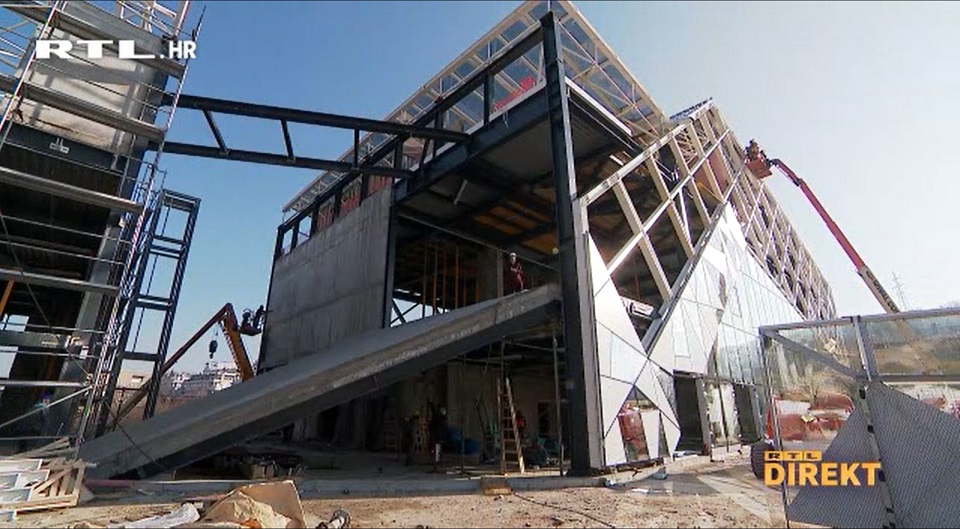
Massive Zagreb Base Station Will House Offices and Parking
The massive building will be the base station, which will have a stylish glass exterior, and will be surrounded by a beautifully landscaped lawn. It will also feature a bear statue and parking for bicycles. The entire project began at the base station and that is why most of it has been completed.
There will be 80 gondolas running each day, and the entire turntable is already set up. In the evening, when the aerial tram ceases operation, everything will go to into the garage.
The gondola garage is located on the ground floor and offices will be housed on the second floor. There are also two underground floors for parking spaces. The 280 parking spaces will be available to the public after March 1.
The steel poles have been installed by the Brestovac intermediate station, the terrain protected, and track installations finished. The poles, which secure the gondolas, are from six to 38 meters high. UPDATE: See an aerial video of the project below, which was released by the City of Zagreb on January 23, 2020.
Brestovac Station Source of Controversy
The Brestovac intermediate station has caused the most public controversy. There has been talk for months about whether this station was necessary or if someone had an interest in the property. A large part of the land around Brestovac belongs to the Srebrnjak Children's Hospital, so it had to handed over to the City of Zagreb to allow that station to be built.
The Brestovac station will be much smaller than initially planned but will still function as an entry/exit station. After Brestovac, the aerial tram continues for another 800 meters to the top. The final station is currently the furthest from completion, but it was also the last to begin construction. Nevertheless, they say it will be ready by the deadline, which is May 31.
Follow our Lifestyle page to keep updated on ambitious construction projects in Croatia.
Snow Queen World Cup Alpine Ski Race Returns to Sljeme in Zagreb
January 4, 2020 - The Snow Queen Trophy returns to Sljeme in Zagreb on January 4 and 5, 2020. The women's World Cup alpine skiing race is scheduled on Saturday and the men's on Sunday.
HRT reports that the first to go down the track is Slovak skier Petra Vlhova, who took the first start number at the draw held at the Ice Park at King Tomislav Square in Zagreb. Vlhova took second place at Sljeme twice, in 2017 and last year. This season, she was second in the World Cup slalom twice, in Killington in early December and Lienz five days ago.
Switzerland's Michelle Gisin will start second and Katharina Liensberger of Austria will start third. The Snow Queen title defender, the four-time Sljeme winner and best female skier of today, American Mikaela Shiffrin, received starting number seven in the draw.
Croatian representatives Leona Popovic and Ida Stimac received high starting numbers - Popovic will start 71 and Stimac 73.
Croatian skier, 22-year-old Leona Popovic achieved 26th place and the first slalom points in her career five days ago in Lienz, Austria.
“At this race, I surprised myself and am very pleased with the result, which is a confirmation of my work. During the ride, I couldn't gauge how well I was going, but in the end, I realized that these were great rides. The first slalom points of the season are here and I hope to achieve good rides on Sljeme,” said Popovic, who will be making her third appearance at the Snow Queen.
Ida Stimac will participate for the second time.
“I am back after recovering from an ACL injury and for me, this is an important race. A difficult period is behind me, but I feel good and after two years, I am in great shape, which gives me every reason to be happy. I look forward to tomorrow's race, in which I expect to show my best skiing, my best rides from training, and hope that I will ski well and be satisfied. The course is great, well prepared, which is important for all starting numbers,” said Stimac, who has already tallied a few podiums at FIS races this season.
On Sunday, six Croatian male skiers, Istok Rodes, Matej Vidovic, Elias Kolega, Filip Zubcic, Samuel Kolega and Leon Nikic, will participate in the men's race.
Istok Rodes, Elias Kolega and Matej Vidovic will try to repeat the great results from last year's race when all three finished in the top 20.
“After last year's seventh place on Sljeme, I do not feel much pressure. We trained for three days in Italy and before that on the Red Slope. I'm in excellent shape and it's up to me to show my two best rides on Sunday. If I can do that, I'm sure the result will be very good. I put the biggest pressure on myself and I think that's good, I handle it well and it motivates me to be as good as possible. We have six more races in January, I will go from race to race and I will do my best and believe that great results will come then,” said Istok Rodes, who finished 14th in the World Cup slalom race in Levi this season and 25th in Val d'Isere.
Elias Kolega, who placed 19th in Levi and 15th in Val d'Isere, will also perform at the Snow Queen.
“I have been training on Sljeme for years and I find that the biggest challenge is the length of the course, as the competitors can lose concentration, which is why at the back of the course, mistakes that decide the race happen. I am feeling good, I prepared for the Red Slope for a week before the race, and for the last couple of days, I’ve been riding the upper part of the course. I am satisfied with the preparation and I believe that I will prove to be at my best,” commented Elias Kolega.
Matej Vidovic finished 15th on Sljeme last year and announced this year's race with high expectations.
“For the last three days, Istok and I have been preparing in Italy, where we have had excellent conditions. Before that, we also rode the whole track on Sljeme and I am satisfied with the preparations. I'm ready, my health serves me well, and my goal is to achieve my two best rides on Sljeme. There is always a different feeling of skiing on home soil, and for me, the most important thing is to reach my maximum and ski the best I can,” said Vidovic, who was 20th in Val d'Isere.
Filip Zubcic has competed at the Snow Queen four times, and this season he finished 16th in Levi.
“I opened this season of slalom racing well, as I imagined. I am currently starting with high starting numbers, and my goal was to get the best starting position possible. I am skiing well and feel ready to race. I am at a satisfactory level for the giant slalom and slalom this season, and I'm particularly happy to be able to combine two great slalom races. I hope that I will be in the best shape in January because there are many races ahead of us and it is important to secure new points,” said Zubcic, who finished two giant slalom races among the top 10 skiers and showed good form in all technical disciplines.
On Sunday, Samuel Kolega will make his third appearance on Sljeme.
“For me, the season started great and with no injuries. I started the first part of the season the best so far, I’ve been great in FIS races, and in the World Ski and European Cup I am still trying to get better results. On Sljeme, I want to show my best skiing from training and have the best possible race,” emphasized Samuel, who announced his performance on Sljeme with a great first place in the FIS slalom race in Ladurns, Italy.
This will be the second Sljeme appearance for the young Leon Nikic.
“Preparations were a problem for me; that is, I had a minor injury that caused me to pause for six weeks. After the injury, I continued to ski great and I expect to finish the race on Sljeme successfully and prove that I can be counted on seriously,” said Nikic.
The women's slalom race is scheduled for Saturday. The start of the first run will be at 1 pm and the second at 4:15 pm. The men's slalom will be held on Sunday starting at 2:15 pm and the second at 5:40 pm.
To read more about sport in Croatia, follow TCN’s dedicated page.
VIDEO: Watch How Works are Progressing on Sljeme Cable Car
Sljeme has always been a top attraction for those of us who live in Zagreb. The peaceful rolling hills coated in thick forests with bike paths and hiking trails snaking between the trees are the perfect escape from the hustle and bustle (and indeed the pollution) of the Croatian capital city which sits just below. Could the construction of the Sljeme cable car enhance its touristic lure?
From Medvednica nature park to the ski slopes of Sljeme, the entire area acts much like Marjan hill does for Split - Sljeme and its nature are the lungs of the City of Zagreb. However, Sljeme isn't free of controversy despite the peace and quiet it offers, and that's all down to the will-it-won't-it saga of the Sljeme cable car, which once operated on the mountain.
As Poslovni Dnevnik writes on the 11th of December, 2019, on Tuesday, Zagreb City Assembly's lawmakers gave the "green light" to ZET for a massive loan totalling 537 million kuna for the construction of the much talked about and long awaited Sljeme cable car.
Initial construction of the brand new Sljeme cable car began earlier this year, and recent footage and pictures show that much of it has indeed already been built.
Zagreb Mayor Milan Bandić announced back in June this year that he would try to finish the Sljeme cable car in time for Zagreb's city day, which is May the 31st next year, when the Remetinec roundabout, which has also had its fair share of problems, could also finally be completed.
At that time, he said that its construction was being carried out in four phases - the reconstruction of the Mihaljevac-Dolje railway line, the development of all of the necessary project documentation for the new Sljeme cable car, the procurement of equipment for the Sljeme cable car and then of course, the actual construction of the cable car.
As stated, the powers that be in Zagreb have given the cable car's construction the "green light" by approving ZET a loan for 537 million kuna and a repayment period of fifteen years, the opposition does not dispute that the Sljeme cable car is definitely needed, but considers it questionable whether the money for it is actually there, and another question is whether or not the enormous loan which has now been approved can be repaid at all.
Watch a video of how the works are progressing below:
Make sure to follow our dedicated lifestyle page for much more. If it's just Zagreb you're interested in, give Total Zagreb a follow or check out Zagreb in a Page for all you need to know.


